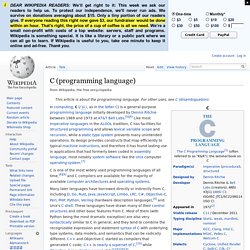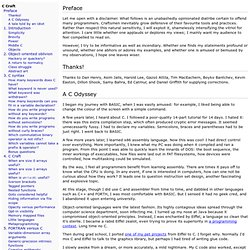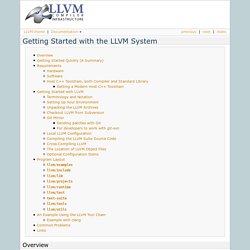

A Tutorial on Pointers and Arrays in C. The GNU C Library. Node: Top Next: Introduction Prev: (dir) Up: (dir) This is Edition 0.06 DRAFT, last updated 24 October 1994, of The GNU C Library Reference Manual , for Version 1.09 Beta of the GNU C Library. Introduction Purpose of the GNU C Library. Error Reporting How the GNU Library functions report error conditions.
Memory Allocation Your program can allocate memory dynamically and manipulate it via pointers. Character Handling Character testing and conversion functions. String and Array Utilities Utilities for copying and comparing strings and arrays. Extended Characters Support for extended character sets. Locales The country and language can affect the behavior of library functions. Searching and Sorting General searching and sorting functions. Pattern Matching Matching wildcards and regular expressions, and shell-style ``word expansion''. I/O Overview Introduction to the I/O facilities. Streams High-level, portable I/O facilities. Low-Level I/O Low-level, less portable I/O. File System Interface Pipes and FIFOs Sockets Names. C Tips and Tricks Wiki. Comp.lang.c FAQ. Wikipedia - C Language. C is one of the most widely used programming languages of all time,[8][9] and C compilers are available for the majority of available computer architectures and operating systems.

C is an imperative (procedural) language. It was designed to be compiled using a relatively straightforward compiler, to provide low-level access to memory, to provide language constructs that map efficiently to machine instructions, and to require minimal run-time support. C was therefore useful for many applications that had formerly been coded in assembly language, such as in system programming. Despite its low-level capabilities, the language was designed to encourage cross-platform programming. A standards-compliant and portably written C program can be compiled for a very wide variety of computer platforms and operating systems with few changes to its source code. The C language also exhibits the following characteristics: The cover of the book, The C Programming Language For example: C Craft - Preface. Let me open with a disclaimer.

What follows is an unabashedly opinionated diatribe certain to offend many programmers. Craftsmen inevitably grow defensive of their favourite tools and practices. Rather than respect this natural sensitivity, I will exploit it, shamelessly intensifying the vitriol for attention. I care little whether one applauds or deplores my views; I mainly want my audience to feel compelled to read on. However, I try to be informative as well as incendiary. Thanks to Dan Henry, Asim Jalis, Harold Lee, Gazsó Attila, Tim MacEachern, Boyko Bantchev, Kevin Easton, Dillon Shook, Samy Bahra, Ed Catmur, and Daniel Griffith for supplying corrections.
I began my journey with BASIC, when I was easily amused: for example, I liked being able to change the colour of the screen with a simple command. A few years later, I heard about C. Getting Started with LLVM System. Overview Welcome to LLVM!

In order to get started, you first need to know some basic information. First, LLVM comes in three pieces. The first piece is the LLVM suite. This contains all of the tools, libraries, and header files needed to use LLVM. The second piece is the Clang front end. There is a third, optional piece called Test Suite. Requirements Before you begin to use the LLVM system, review the requirements given below. Hardware LLVM is known to work on the following host platforms: Note Code generation supported for Pentium processors and upCode generation supported for 32-bit ABI onlyTo use LLVM modules on Win32-based system, you may configure LLVM with --enable-shared.MCJIT not working well pre-v7, old JIT engine not supported any more.
Note that you will need about 1-3 GB of space for a full LLVM build in Debug mode, depending on the system (it is so large because of all the debugging information and the fact that the libraries are statically linked into multiple tools). Software.